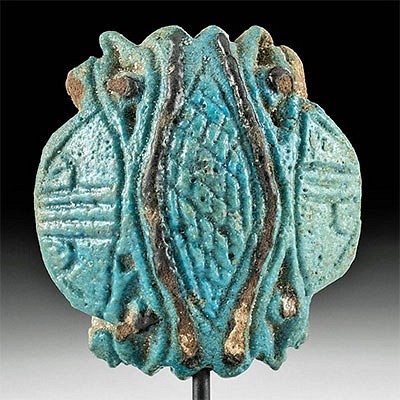Chavin Incised Stone Bowl w/ 2-Headed Serpent
Lot 158
About Seller
Artemis Fine Arts
686 S Taylor Ave, Ste 106
Louisville, CO 80027
United States
Selling antiquities, ancient and ethnographic art online since 1993, Artemis Gallery specializes in Classical Antiquities (Egyptian, Greek, Roman, Near Eastern), Asian, Pre-Columbian, African / Tribal / Oceanographic art. Our extensive inventory includes pottery, stone, metal, wood, glass and textil...Read more
Estimate:
$6,000 - $9,000
Absentee vs Live bid
Two ways to bid:
- Leave a max absentee bid and the platform will bid on your behalf up to your maximum bid during the live auction.
- Bid live during the auction and your bids will be submitted real-time to the auctioneer.
Bid Increments
| Price | Bid Increment |
|---|---|
| $0 | $25 |
| $300 | $50 |
| $1,000 | $100 |
| $2,000 | $250 |
| $5,000 | $500 |
| $10,000 | $1,000 |
| $20,000 | $2,500 |
| $50,000 | $5,000 |
| $100,000 | $10,000 |
| $200,000 | $20,000 |
About Auction
By Artemis Fine Arts
May 27, 2021
Set Reminder
2021-05-27 10:00:00
2021-05-27 10:00:00
America/New_York
Bidsquare
Bidsquare : CLEARANCE | Antiquities & Ethnographic Art
https://www.bidsquare.com/auctions/artemis-gallery/clearance-antiquities-ethnographic-art-7010
Featuring discounted pricing and many new items! Asian art, Classical antiquities from Egypt, Greece, Italy, and the Near East...plus Pre-Columbian, Tribal, Russian Icons & Enamelware, Spanish Colonial, Fine Art, more! Some starting prices have been reduced up to 65% from original auction prices! Artemis Fine Arts info@artemisgallery.com
Featuring discounted pricing and many new items! Asian art, Classical antiquities from Egypt, Greece, Italy, and the Near East...plus Pre-Columbian, Tribal, Russian Icons & Enamelware, Spanish Colonial, Fine Art, more! Some starting prices have been reduced up to 65% from original auction prices! Artemis Fine Arts info@artemisgallery.com
- Lot Description
**Originally Listed At $5000**
Pre-Columbian, North Coast Peru, Chavin culture, ca. 1200 to 500 BCE. A stunning bowl of a petite size, hand-carved from dark green, nearly black stone. The vessel is defined by a round but stable base, convex walls that taper to a thin rim, and a deep interior basin. The exterior boasts a pair of abstract, Janus-headed serpents with triangular heads, densely incised crosshatch motifs indicative of scales, and beautiful inlaid greenstone fragments ranging in color from emerald green to vibrant turquoise. Both the body and base are similarly detailed with dozens of crosshatch incisions, and the interior is incredibly smooth. An exceedingly rare example of early Chavin artistry! Size: 2.6" W x 1.7" H (6.6 cm x 4.3 cm).
Snake/serpents provide a fascinating element of Pre-Columbian iconography as they were regarded to be a beneficial source of nourishment and at the same time quite deadly with their poisonous venom. Also important to the indigenous was the fact that snakes shed their skin annually thus rejuvenating themselves and serving as symbols of renewal and good health. The existence of two snake heads on this piece may suggest the bicephalic serpent which was a signifier of high rank in various Pre-Columbian world views. These two-headed beasts were regarded as sky bands that arched over the earth or surrounded the seas serving as a passageway for the planets and stars of the celestial realm.
The Chavin people lived in the northern Highland Andes, and their capital, Chavin de Huantar, is an UNESCO World Heritage Site. The artwork of Chavin represents the first widespread style in the Andes. The center of Chavin de Huantar is a massive, flat-topped pyramid, surrounded by lower platforms. Between 1200 and 500 BCE the pyramid space was used for religious ceremonies. The Old Temple, constructed very early in the history of the site, consists of a series of passageways built around a circular courtyard; within were carved stone monuments showing jaguars, serpents, and other figures with transformative and/or anthropomorphic figures. At the very center is a towering stone stela depicting an anthropomorphic figure with a jaguar head and a human body, believed to be Lanzon, the chief deity of Chavin. Researchers believe that worshippers ingested hallucinogenic drugs, held in vessels like this one, and then were led in the dark through the labyrinthine passageways before entering the central courtyard and coming abruptly face-to-face with the snarling features of the god.
Provenance: private Toronto, Ontario, Canada collection; ex-Artemis Gallery, 2014; ex-private Hawaii, USA collection; ex-Fred Leighton collection, New York, New York, USA; ex-Alexander Acevedo collection; ex-Arte Primitivo Gallery, New York, New York, USA
All items legal to buy/sell under U.S. Statute covering cultural patrimony Code 2600, CHAPTER 14, and are guaranteed to be as described or your money back.
A Certificate of Authenticity will accompany all winning bids.
We ship worldwide and handle all shipping in-house for your convenience.
#150163Minor nicks to body, base, and some inlaid stones, with softening to some finer incised details, and light encrustations within some recessed areas, otherwise intact and near choice. Light earthen deposits throughout.Condition
- Shipping Info
-
All shipping is handled in-house for your convenience. Your invoice from Artemis Gallery will include shipping calculation instructions. If in doubt, please inquire BEFORE bidding for estimated shipping costs for individual items.
-
- Buyer's Premium



 EUR
EUR CAD
CAD AUD
AUD GBP
GBP MXN
MXN HKD
HKD CNY
CNY MYR
MYR SEK
SEK SGD
SGD CHF
CHF THB
THB















